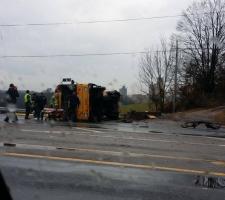
Road crashes are not as random as they may appear and analysing data can reveal patterns that can help various authorities target their resources more accurately. David Crawford reports.
Figures from the US
Responses to the challenge already being implemented on the country’s highways include a wide spread of interventions. Physical ones include improvements in roadway geometries and alignments.
Among technological ones are traffic signal phasing weighted by vehicle type, radar-activated stop signs, and intersection conflict warning systems at junctions with historically high crash rates. The last are particularly relevant in rural areas, where up to 70% of fatal collisions can occur.
The effects of these measures can be systematically predicted and evaluated using nationally defined crash reduction factors, in resources such as the Crash Reduction Analysis System Hub deployed by the Florida Department of Transportation.
Crash data
Meanwhile, there is growing emphasis on the value of mining and analysing crash data. The US’ Towards Zero Deaths national strategy on highway safety, published in June 2014, is driving a ‘sustained and even accelerated decline in transportation-related deaths and injuries’ and highlights the importance of ‘a more coordinated, consistent approach to data collection and analysis.’
It accepts that ‘limitations are very much the norm’ and stresses the need for the further development of tools and procedures that support the data-driven consideration of safety. Even when available data is not ideal, it says, this will help to further the inclusion of safety in policy and decision-making regarding highways management.
Established tools available for carrying out the strategy include Data-Driven Approaches to Crime and Traffic Safety (DDACTS), a law enforcement operational system supported by a partnership between the NHTSA and agencies of the US Department of Justice. It integrates location-based crime and crash data, using geo-mapping to identify high incident hot spots. The aim is to optimise law enforcement resources given the competing demands on them, drawing on the deterrent value of highly visible traffic enforcement and the knowledge that crimes often involve motor vehicles.
Analysis
The linkage between the two types of incident is apparent in a more recent and focused approach. This involves using detailed, long-term statistical analysis to forecast and update the likely location and times of incidents to enable the proactive allocation and direction of resources in anticipation. Predictive analytic technology developed by IBM is now being used by the Tennessee Highway Patrol, which introduced a version called CRASH (Crash Reduction Analysing Statistical History) in 2014. It is one of the few US states to have done so.
The deployment follows the earlier installation by Memphis Police Department of a crime- (including vehicle crime-) related version called CRUSH (Criminal Reduction Utilising Statistical History) - also supplied by
Contrastingly, the Memphis Police Department is one of a number across the US to use such systems and at one point, it achieved 70 arrests within two hours – the normal tally for a full weekend.
Over a six-month piloting period, the system adopted by the Tennessee Highway Patrol provided results shown to have 72% accuracy. The programme breaks the state up into 8km by 9.6km squares, and predicts serious traffic risks within them, with four-hourly updates, to give a percentage probability.
If this is high in a given square, a Tennessee Highway Patrol captain can send troopers out to try and prevent crashes – for example, through their visibility. If an incident does occur, they will already be in the vicinity, able to help reduce the risk of further vehicles piling in and to summon early emergency aid.
Data input analysed by the Tennessee system includes the dates and locations of major upcoming events, weather forecasts and the locations of previous alcohol-related incidents or arrests, based on areas where there have previously been high levels of citations issued. Distracted driving is being added to the list.
An earlier system, designed for use by the Ohio State Highway Patrol, and claimed to have been the first of its kind in the US, is no longer operational. Developed by the Statistical Consulting Service of the state’s Department of Statistics, it drew on five years’ worth of historical crash data and research by North Carolina-based business intelligence market specialist SAS.
Predictions
Department staff input the results into existing statistical and mapping software to create a colour-coded geographical map of crash-risk levels on segments of the state highway network which are displayed in the Patrol’s headquarters.The Department claimed to be able to make predictions for every major roadway in Ohio, under all possible road conditions, for every hour of the day, every day of the week.
The Department of Statistics also made this analytical software freely available, with a view to its being adapted by other interested US states. The eventual, ambitious plan was to feed data direct to drivers through mobile devices or portable navigation systems to warn them in advance of the heightened crash risks.
Neither the Department, nor the State Highway Patrol was able to give any results from the trial, or explain why it ended. An SAS spokesperson told ITS International that the company is working on similar projects for other states, but declined to name any of these.
Roadway improvements
Florida Department of Transportation (FDOT) also adopted the CRASH acronym for its Crash Reduction Analysis System Hub, a web-based information resource developed for the use of its Safety Office. Running on the departmental intranet, it is designed to update and apply, across the state, crash reduction factors to estimate the expected reduction in crashes that will occur during a specified period following the implementation of a proposed safety improvement project.The crash reduction factor gives the percentage crash reduction that might statistically be expected after the implementation.
For example, the installation of centreline rumble strips on a two-lane US roadway could expect a 14% reduction in all crashes and a 55% reduction in head-on ones, according to the US Department of Transportation’s Federal Highway Administration (FHWA).
Crash reduction factors are based on previously completed projects. They take account of local conditions, such as road type, traffic levels, the weather and the crash investigation methods used - which can vary from agency to agency - in order to indicate the likely effectiveness of alternative improvements.
While FDOT had long maintained a comprehensive crash database for its state highway network, specific data was being kept separately at individual district offices, in different formats, and was not easily accessible for developing the crash reduction factors. The department therefore had no central statistical resource capable of combining crash and safety project data to determine the most relevant factors. Nor was there a mechanism to provide the FHWA with comprehensive reports on project effectiveness, for the benefit of national information gathering and policy-making.
To fill the gap, FDOT funded a research project at the Lehman Center for Transportation Research at Florida International University to develop the CRASH application for systematically collating and managing safety improvement project data and updating crash reduction factors. It has been developed as a Microsoft ASP.NET web application that works with Microsoft Access databases.
District safety engineers now routinely input data on all completed US Highway Safety Improvement Program-funded projects into CRASH, which then draws on before and after crash counts to enable evaluation. The engineers can also use it for assessing proposed safety measures and subjecting these to prior benefit-cost analyses by inputting project details and selecting crash data years.
The state safety engineer, acting as system administrator, updates all crash reduction factors at least once a year, typically using five years’ worth of before and after data. CRASH currently includes data on more than 130 different types of improvements.
About the Author
- David Crawford has spent 20 years writing about and researching ITS and is a Contributing Editor to ITS International.













